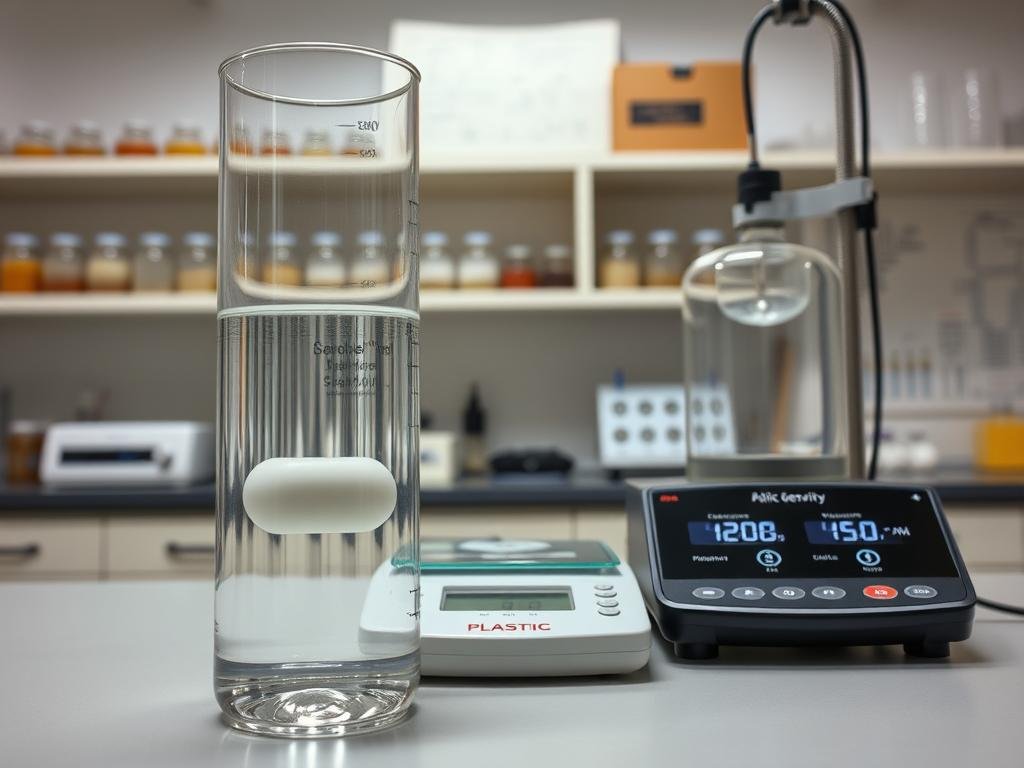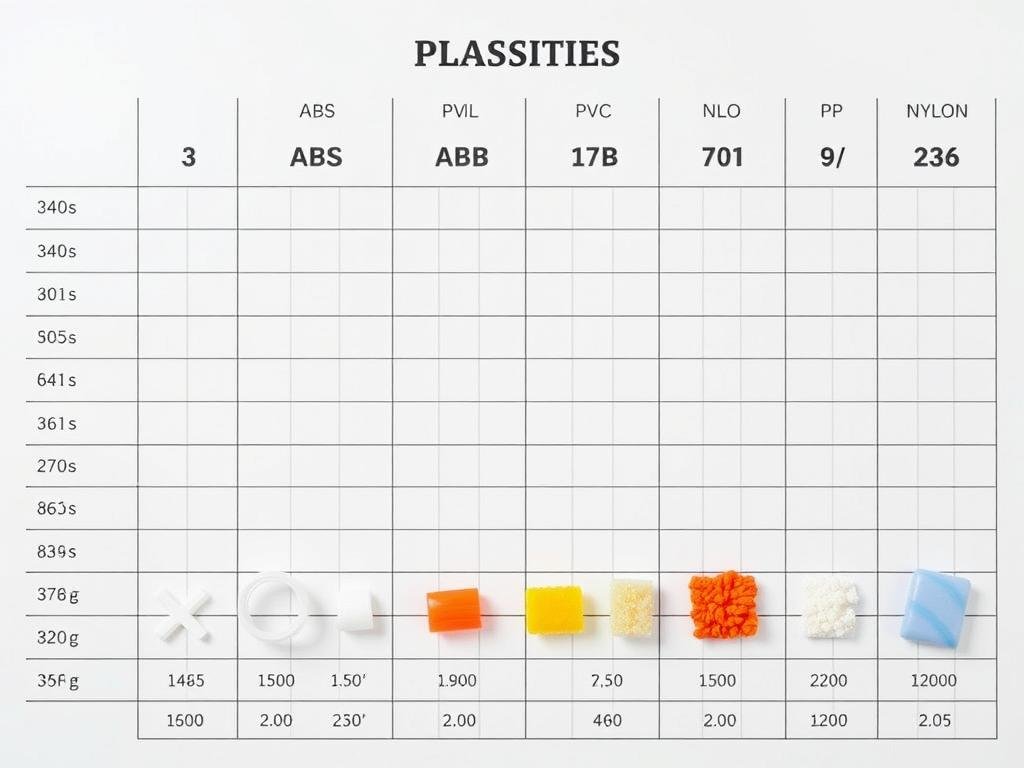Plastics have become essential materials in modern society, with applications ranging from everyday objects to industrial manufacturing, electronic devices, and medical equipment.
The density of a plastic material is a crucial factor that influences its physical properties, performance, and suitability for different uses. Understanding the density of various plastics is vital for engineers, designers, and manufacturers who need to select the optimal material for their applications.
This comprehensive guide explores the density of common thermoplastics like ABS, PVC, PP, and engineering plastics like Nylon, providing precise density values for material comparison and informed decision-making.
Understanding Plastic Density and Specific Gravity
Understanding the density of plastics is crucial for determining their applications and processing methods. Density is a fundamental property that affects the performance and usability of plastic materials.
What Is Plastic Density?
Plastic density refers to the mass per unit volume of a plastic material. It is typically expressed in units such as grams per cubic centimeter (g/cm³) or kilograms per liter (kg/L). The bulk density of plastic materials, which includes the weight of material depending on the specific volume, is also an important characteristic, especially for granular or powdered plastics.
Density vs. Specific Gravity: Key Differences
While often used interchangeably, density and specific gravity are related but distinct properties. Density is an absolute measure of mass per unit volume, whereas specific gravity is a relative measure comparing the density of a material to that of water at a reference temperature. Understanding the difference between these two properties is essential for accurate material characterization.
How to Measure Plastic Density
Several methods exist for measuring plastic density, including water displacement, liquid pycnometry, and gradient column techniques. The water displacement method is commonly used for solid plastics, where the sample is weighed in air and then in water to calculate density using Archimedes’ principle. Modern laboratory equipment, such as density meters and automatic pycnometers, provide highly accurate density measurements.

Different measurement methods may be required depending on the form of the plastic and its expected density range. Density measurements are often performed at standardized temperatures to ensure consistency and comparability of results.
Comprehensive Plastic Density Chart
Plastic density is a critical factor that influences the strength, resistance, and overall performance of plastic materials. Understanding the density of various plastics is essential for selecting the right material for specific applications and industries.
Common Thermoplastics
Common thermoplastics such as ABS, PVC, PP, and PE are widely used in various products due to their favorable properties and relatively low cost. The densities of these materials range from approximately 0.9 g/cm³ for PE to 1.4 g/cm³ for PVC.
| Material | Density (g/cm³) |
|---|---|
| ABS | 1.04-1.07 |
| PVC | 1.3-1.4 |
| PP | 0.9-0.91 |
| PE | 0.91-0.96 |
Engineering Plastics
Engineering plastics like Nylon, PEEK, and PET offer superior mechanical properties and thermal resistance, making them suitable for demanding applications. Their densities vary, with Nylon having a density around 1.13-1.15 g/cm³ and PEEK around 1.3 g/cm³.

Specialty and High-Performance Plastics
Specialty and high-performance plastics, including PTFE, PPS, PEI, and LCP, are designed for extreme environments and applications. Their densities range from 1.27 g/cm³ for PEI to 2.2 g/cm³ for PTFE.
| Material | Density (g/cm³) |
|---|---|
| PTFE | 2.10-2.20 |
| PTFE +25% GF | 2.20-2.30 |
| PPS | 1.35 |
| PPS +20-30% GF | 1.40-1.60 |
| PPS +40% GF | 1.60-1.70 |
| PEI | 1.27-1.30 |
| PEI +30% GF | 1.50-1.60 |
| LCP | 1.40 |
| LCP + CF | 1.50 |
| LCP + GF | 1.50-1.80 |
These high-performance plastics are used in applications requiring exceptional resistance to temperature, chemicals, and mechanical stress. Their unique properties make them indispensable in industries such as aerospace, electronics, and healthcare.
How Plastic Density Affects Material Properties
Understanding how plastic density impacts material properties is essential for selecting the right materials for specific uses. The density of a plastic material influences its overall performance, from physical and mechanical characteristics to processing and production efficiency.
Impact on Physical and Mechanical Properties
The density of plastic materials significantly affects their physical and mechanical properties. Generally, higher density plastics tend to have improved mechanical strength and durability. For instance, high-density polyethylene (HDPE) is known for its robustness and resistance to impact, making it suitable for applications such as containers and piping. On the other hand, lower density plastics may offer greater flexibility and are often used in packaging materials and films.
| Material | Density (g/cm³) | Mechanical Strength |
|---|---|---|
| HDPE | 0.95-0.97 | High |
| LDPE | 0.91-0.93 | Medium |
| PP | 0.90-0.91 | Medium-High |
Thermal Properties and Heat Resistance
Plastic density also influences thermal properties and heat resistance. Higher density plastics often exhibit better heat resistance, making them suitable for applications that involve exposure to high temperatures. For example, polycarbonate (PC) and polyetheretherketone (PEEK) are high-performance plastics known for their excellent thermal stability and are used in demanding applications such as aerospace and automotive components.
Thermal stability is crucial for plastics used in high-temperature applications. The density of these materials contributes to their ability to maintain structural integrity under thermal stress.
Processing Performance and Flowability
In plastic processing, materials with lower density often show better flowability and moldability. Lower density means weaker intermolecular forces, allowing the plastic to flow and form more easily. For instance, PET is known for its excellent flowability and moldability, making it well-suited for bottle manufacturing. Techniques to adjust PET density or modify its properties can further optimize processing performance, improving both production efficiency and product quality.
The relationship between density and processing performance is critical in determining the suitability of a plastic material for a specific application. By understanding how density affects flowability, moldability, and overall processing efficiency, manufacturers can optimize their production processes and achieve higher quality products.
Applications Based on Plastic Density
The density of plastics is a crucial characteristic that affects their use in numerous applications, from packaging to medical devices. Various industries rely on different types of plastics based on their density, which influences their physical and mechanical properties.
Packaging Industry Applications
In the packaging industry, plastics of varying densities are used to manufacture containers, bottles, and films. For instance, PET (1.30-1.40 g/cm³) is widely used for beverage bottles due to its excellent barrier properties and chemical stability.
Construction and Building Materials
The construction industry utilizes plastics with different densities for various applications, such as piping, insulation, and roofing materials. Higher-density plastics like polycarbonate are used for durable components.
Electronics and Electrical Components
In the electronics industry, plastics of different densities are used for manufacturing components, such as connectors, switches, and housings. The density of these plastics affects their thermal properties and resistance to electrical current.
Medical and Healthcare Applications
The medical sector employs plastics with a range of densities for various applications, including implantable devices, diagnostic equipment, and disposable supplies. For example, UHMWPE (0.93-0.95 g/cm³) is used for orthopedic implants due to its exceptional wear resistance and biocompatibility.
| Application | Typical Plastic Material | Density (g/cm³) |
|---|---|---|
| Packaging (Bottles) | PET | 1.30-1.40 |
| Orthopedic Implants | UHMWPE | 0.93-0.95 |
| Medical Equipment Housings | Polycarbonate | 1.20 |
The diverse applications of plastics based on their density highlight the importance of material selection in product design and manufacturing. By understanding the properties of different plastics, industries can optimize their use of materials to achieve desired performance characteristics.
Conclusion: Importance of Plastic Density in Material Selection
As technology advances, the importance of plastic density in material selection continues to grow, driving innovation and sustainability. The density of plastic materials is a vital factor that influences their performance, application, and overall cost. Understanding the density ranges of various plastics allows for more informed decision-making in material selection.
The strategic selection of materials based on density enables engineers and designers to optimize products for specific requirements, balancing factors like weight, strength, and environmental impact. Bulk density considerations are crucial in material handling, storage, and processing, affecting costs and equipment sizing. The wide range of available plastic densities provides designers with flexibility to meet diverse application requirements.
Future trends in plastic material development will focus on achieving enhanced performance characteristics while minimizing density, particularly for applications where weight reduction translates to energy savings. Density testing and quality control remain crucial for ensuring consistent performance in finished products. As manufacturing technologies evolve, the ability to precisely control and customize plastic density will open new possibilities for innovative products across industries.
